Spatial disorientation in queer games
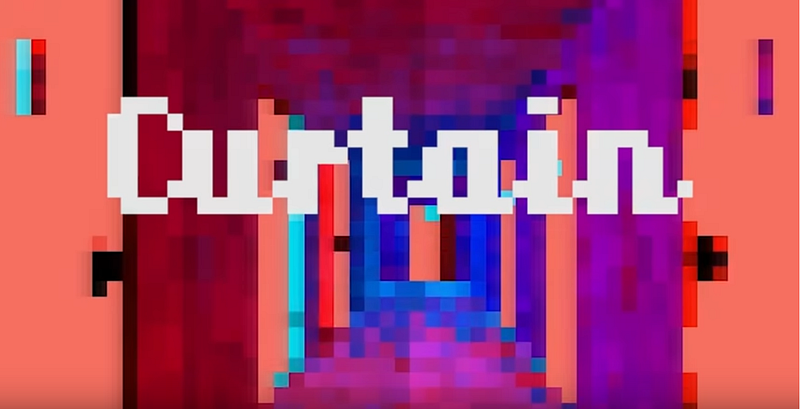 Pictured above: Screenshot from
the trailer of Curtain, courtesy of
DREAMFEEL
Pictured above: Screenshot from
the trailer of Curtain, courtesy of
DREAMFEELContent warning: This essay features a game with implicit mentions of intimate partner violence.
Created by Llaura Dreamfeel, the Irish game developer behind If Found (2017), Curtain (2014) is a first-person interactive game that follows Kaci and Ally, romantic partners and bandmates rising to rock-stardom in Glasgow. As the game progresses, what begins as a seemingly strained relationship quickly escalates, with Kaci exhibiting increasingly problematic behavior. As the player, we are granted access into Ally’s psyche, the perspective of someone attempting to make sense of her abusive relationship and the memories — good and bad — that she must confront every day. From constant put-downs to controlling Ally’s access to a house key or phone, the experience is painful, exacerbated by an almost comically simple visual environment that feels strange and uncomfortable in itself. Within the apartment, distinct features blend into a jumbled of garish red, blue, and green pixels, as the walls and objects that make up a “home” immerse the player in a thoroughly disorienting gameplay experience.
Using Curtain as a case study, I explore stories of queer resistance in hyper-constrained video game environments, ones that warp sensory perceptions of time and space. These are not just “empathy” games — ones meant to allow dominant cultures access to stories of the Other but ones that speak to a “queer” games ethos rooted in the margins of the internet. Within the online queer games community, which itself is amorphous and transient, there has been a push in recent years for queer games made by queer folks — aligning with the mentality that anybody can create a game (additionally, anything can be a game). As AAA game development stretches for better graphics and more complex game mechanics deeply intertwined with cultures of burnout and exploitation of queer and trans Black, Indigenous, and people of color (QTBIPOC), some queer game developers are swimming against the current. They are resisting the profit model of such commercial games, publishing their games on indie platforms like itch.io, often for free or “pay what you want.” Curtain is particularly critically acclaimed, garnering awards such as AMaze 2015’s Grand Prize for The Most Amazing Game and honorable mentions for IGF 2015.
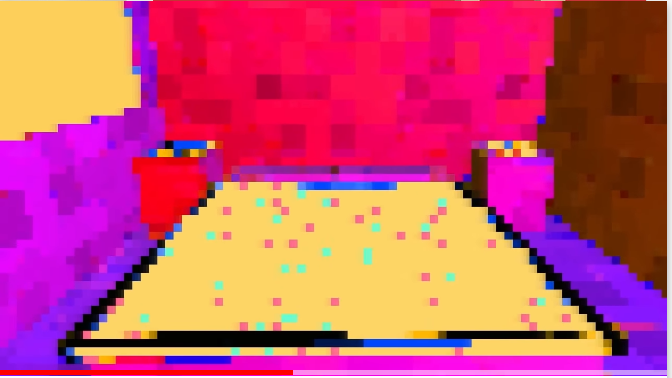 A first-person view of the bed
Ally and Kaci share, a space that becomes increasingly uncomfortable for Ally as the game
progresses
A first-person view of the bed
Ally and Kaci share, a space that becomes increasingly uncomfortable for Ally as the game
progressesThe story progresses as the player interacts with various objects in Kaci and Ally’s home, from her cat, Toast, to old family photos. Playing as Ally, your thoughts and fears manifest in a white box that occupies the top third of the screen. Another third is dedicated to the bottom blue box which contains Kaci’s violent, controlling, and self-absorbed thoughts, narrated in the first person. It is interesting to note that the protagonist’s voice is told in the second person, pointing toward “you” the player and “your” choices — often forced into dialogue simultaneously with Kaci’s insults, gaslighting, and manipulation. In the middle, you can see a sliver of the environment you need to interact with to progress, attempting to make sense of blurry objects and the even blurrier apartment boundaries. Each day, you repeat the same routine, walking through the same apartment, until one day you are able to break your ties to Kaci and exit their home. Even once you are freed from the hostile environment, the text box dedicated to Kaci’s words lingers, as burned into Ally’s consciousness. It is both visually and emotionally difficult to navigate the highly restrictive, pixelated space — communicating in the “trial-and-error” discovery the frustration and repetition of finding a way out.
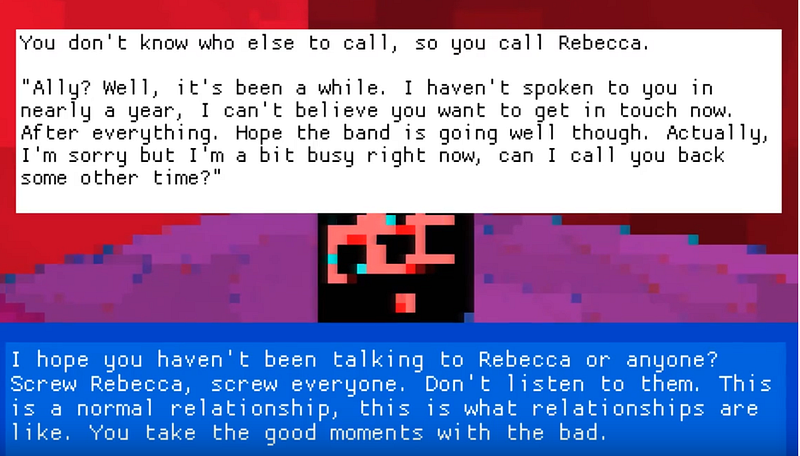 As Ally interacts with the phone,
attempting to reach out for help, Kaci simultaneously dismisses her feelings. The “push-and-pull” of
these large dialogue boxes demonstrate the difficulty Ally faces distinguishing the realities of
abuse from Kaci’s manipulations.
As Ally interacts with the phone,
attempting to reach out for help, Kaci simultaneously dismisses her feelings. The “push-and-pull” of
these large dialogue boxes demonstrate the difficulty Ally faces distinguishing the realities of
abuse from Kaci’s manipulations.There is something to be said also about the “othering” of domestic space present in Curtain, exploring themes such as family acceptance, questions of gender identity, and the lack of a singular blueprint of what a queer relationship should be. Curtain evokes a similar haunting feeling as Carmen Maria Machado’s In the Dream House (2019), an autobiographical story of queer domestic violence told through memories made in the “dream house.” The dream house, for the author, is a space to process and disentangle the pain, love, and violence present in a toxic, abusive relationship. Curtain seems to speak to the commonality of these experiences through the depersonalization of its characters and setting. Both of these characters exist off-screen, even in situations when staring at pixelated photographs or in a shattered mirror. The apartment is simultaneously visually overwhelming and indistinguishable in others, reducing the space to pixelated distortions of primary and secondary colors. As Kaci states, staring from their apartment onto onlooking traffic, “We can see the city from here . . . It looks like any city. We can pretend we are wherever we want. We can pretend we are whoever we want. Just keep it up and it’s true.”
These words foreshadow the harsh reality of abuse: these accounts could happen to anyone, anywhere. As the scenes of violence fade into the mundanity of the everyday, we experience with Ally the extreme measures she takes to feel safe as isolation becomes the new normal.
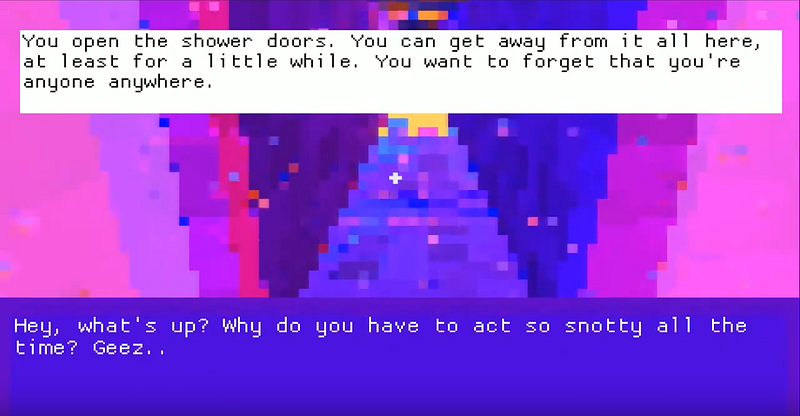 The shower, a space of reprieve
for Ally, serves as both a safe space and a linkage between spaces. Even so, Kaci’s words linger,
never leaving Ally truly alone with her own thoughts.
The shower, a space of reprieve
for Ally, serves as both a safe space and a linkage between spaces. Even so, Kaci’s words linger,
never leaving Ally truly alone with her own thoughts.Spatial disorientation in this case also takes the form of time, which seems to bleed together throughout the course of the game. As memories are uncovered and dialogue is shared, it becomes increasingly unclear exactly what lies in the past, present, and future, as the player continues to endure verbal abuse and be made to question her own perceptions by her partner. Amidst all this, the bathroom exists as a safe space for Ally — a literal portal that connects the two playable rooms of the story (one in the past, one in the future). The bathroom is an “in-between” space to resume and retreat, offering the player a glimpse into the importance Ally places on these few moments alone. It is in these moments, when walking through an “endless” corridor (representing taking a shower) or standing in the bathroom staring at the mirror, that the player maintains agency over how long to exist in these spaces. With no restrictions of passage back and forth between these “rooms” — separated by months of memories the player has to piece together — Curtain allows players the space to progress at their own pace, in queer time, as coined by gender studies scholar Jack Halberstam.
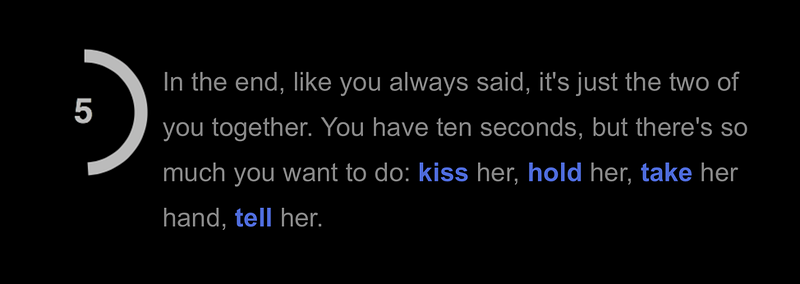
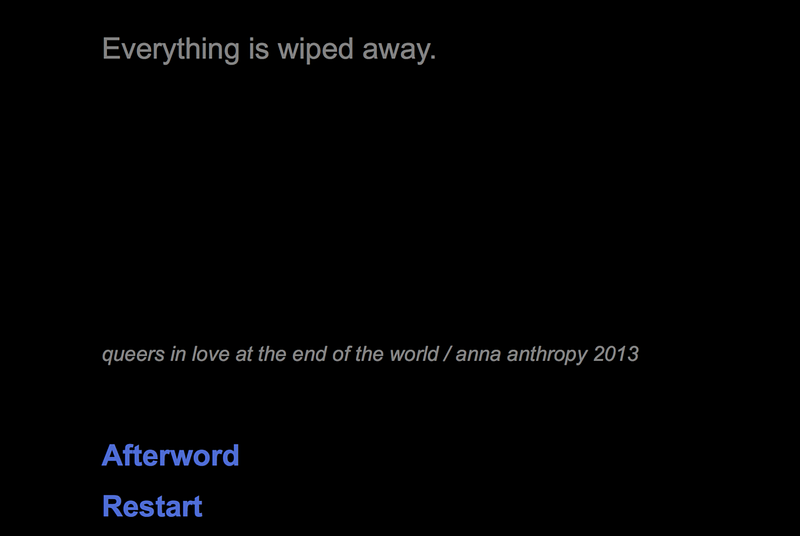 Two screenshots of the
interactive novel Queers in Love at the End of the World (2013), with interactive text
(leading to branching paths) pictured in blue.
Two screenshots of the
interactive novel Queers in Love at the End of the World (2013), with interactive text
(leading to branching paths) pictured in blue.Other games, such as Anna Anthropy’s Queers in Love at the End of the World (2013), examine the use of time as a constraint. Anthropy’s game is a visual novel that can be played in practically a single breath, exploring, in the last ten seconds before the world ends, how to communicate the love you have for your partner. Under extreme time constraints, the text fills the screen in ways that can be overwhelming, ways that you can miss out on all the possibilities of interaction, as you choose branching paths. Do you choose to “tell her,” “hold her,” “kiss her,” or “take her hand?” And from there, what do you do before “the world is wiped away?” In both of these games, so much is communicated in the negative — in the glimpses of what is missing from these scenes. What are the memories and personal experiences we are able to piece together in a state of disorientation and overwhelm?
Queer games stem from a deep history of queer and trans resistance, one that has existed across all technological mediums. This queer liberatory future, while an optimistic vision, is deeply intertwined with movements to make games more diverse, physically accessible, and inclusive. Situated at the margins, queer games work to expand understandings of which stories and experiences are “deserving” of a platform, often turning toward the absurd and unexpected to push the boundaries of the dominant culture. Games like Curtain make visible and affirm a set of experiences too often ignored while challenging expectations of what gameplay should and could look like.
For more news, discourse, and resources on immersive and emerging forms of nonfiction media, sign up for our monthly newsletter.
Immerse is an initiative of the MIT Open DocLab and receives funding from Just Films | Ford Foundation and the MacArthur Foundation. The Gotham Film & Media Institute is our fiscal sponsor. Learn more here. We are committed to exploring and showcasing emerging nonfiction projects that push the boundaries of media and tackle issues of social justice — and rely on friends like you to sustain ourselves and grow. Join us by making a gift today